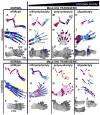Pleiotropic patterning response to activation of Shh signaling in the limb apical ectodermal ridge
- PMID: 21465622
- PMCID: PMC3273424
- DOI: 10.1002/dvdy.22628
Pleiotropic patterning response to activation of Shh signaling in the limb apical ectodermal ridge
Abstract
Sonic hedgehog (Shh) signaling in the limb plays a central role in coordination of limb patterning and outgrowth. Shh expression in the limb is limited to the cells of the zone of polarizing activity (ZPA), located in posterior limb bud mesoderm. Shh is not expressed by limb ectoderm or apical ectodermal ridge (AER), but recent studies suggest a role for AER-Shh signaling in limb patterning. Here, we have examined the effects of activation of Shh signaling in the AER. We find that targeted expression of Shh in the AER activates constitutive Shh signaling throughout the AER and subjacent limb mesoderm, and causes a range of limb patterning defects with progressive severity from mild polydactyly, to polysyndactyly with proximal defects, to severe oligodactyly with phocomelia and partial limb ventralization. Our studies emphasize the importance of control of the timing, level and location of Shh pathway signaling for limb anterior-posterior, proximal-distal, and dorsal-ventral patterning.
Copyright © 2011 Wiley-Liss, Inc.
Figures






References
-
- Bastida MF, Ros MA. How do we get a perfect complement of digits? Curr Opin Genet Dev. 2008;18:374–380. - PubMed
-
- Bell SM, Schreiner CM, Goetz JA, Robbins DJ, Scott WJ., Jr Shh signaling in limb bud ectoderm: potential role in teratogen-induced postaxial ectrodactyly. Dev Dyn. 2005;233:313–325. - PubMed
-
- Blanc I, Bach A, Robert B. Unusual pattern of Sonic hedgehog expression in the polydactylous mouse mutant Hemimelic extra-toes. Int J Dev Biol. 2002;46:969–974. - PubMed
Publication types
MeSH terms
Substances
Grants and funding
LinkOut - more resources
Full Text Sources
Molecular Biology Databases

